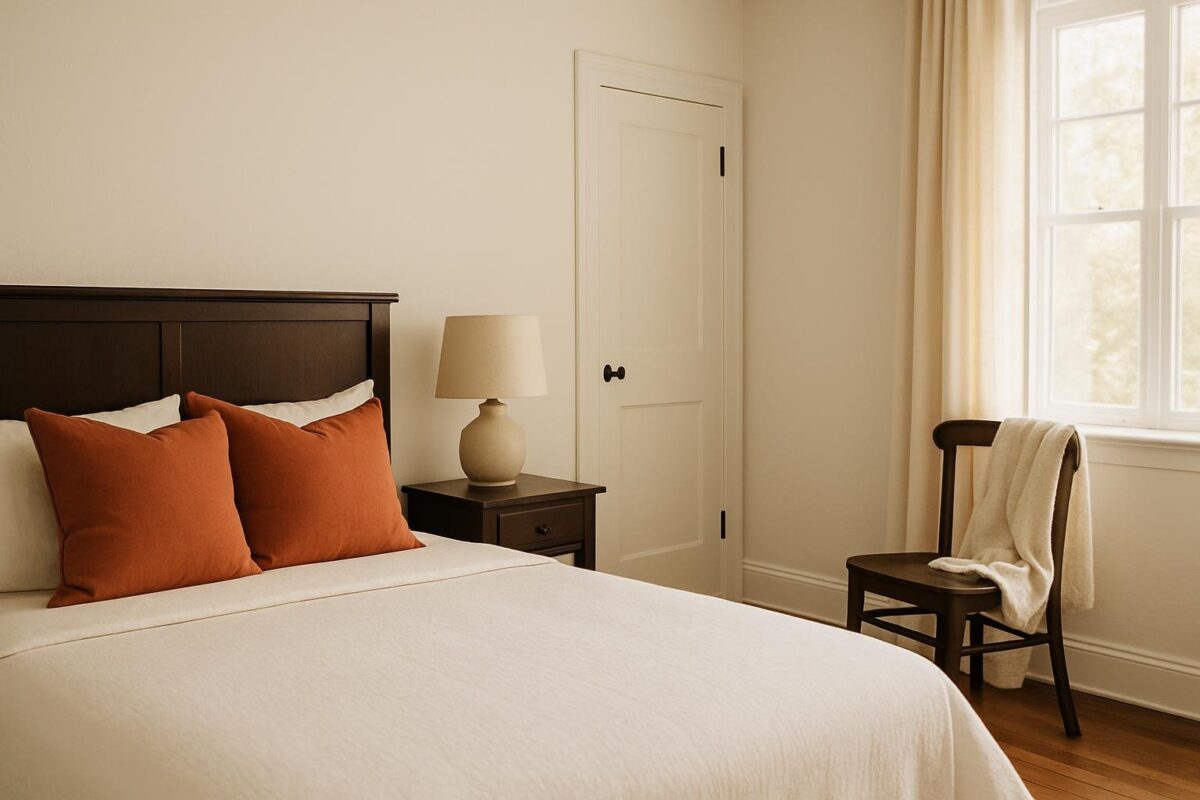A bedroom should feel like a calm retreat, a place to escape the noise of the day. The colors and textures you choose can make all the difference.
Alabaster offers a soft, timeless base that sets a restful tone. By starting with Alabaster, you get a versatile backdrop that supports comfort and style.
You can build on this neutral shade with layers of color and texture that fit your mood and lifestyle. Deep tones add warmth, soft hues bring calm, and natural light shifts the atmosphere as the day goes on.
Each choice shapes how your space feels and how well it helps you recharge. With Alabaster as your starting point, you can use simple accents and thoughtful details to create a bedroom that feels both inviting and personal.
Key Takeaways
- A soft neutral base sets the tone for rest
- Layered accents shape mood and comfort
- Balanced details create a personal retreat
Navy Headboard Meets Gentle Neutrals
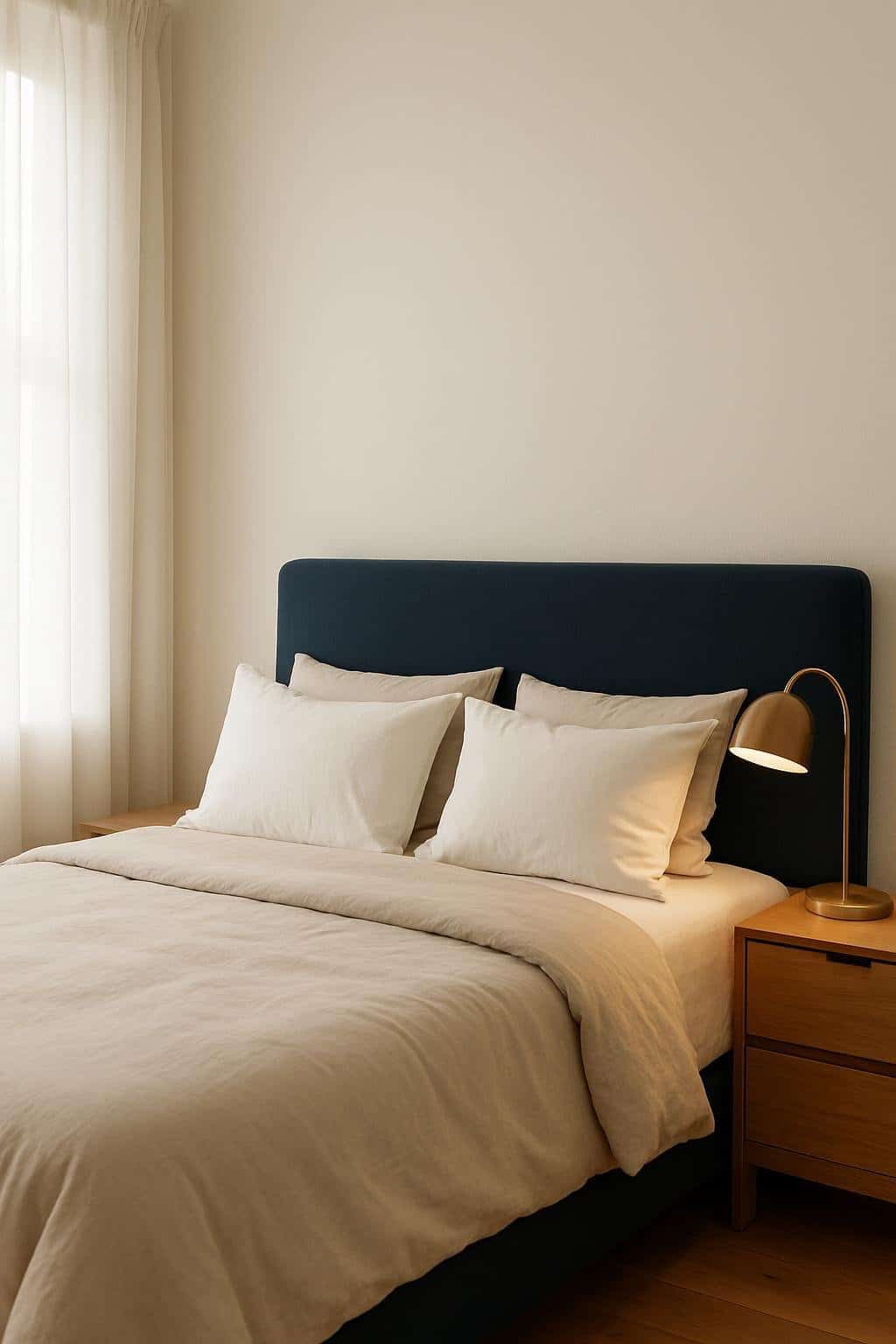
A dark navy headboard creates a strong anchor in the room. Softer neutrals keep the space calm and inviting.
Light bedding, natural wood, and filtered daylight balance the boldness of the headboard. The room stays restful and never feels heavy.
Deep Navy Headboard Grounds The Space
A navy headboard adds depth and focus to your bedroom. Its darker tone draws the eye and gives the bed presence without overwhelming the room.
This color works especially well against lighter walls like alabaster or soft beige. You can pick velvet, linen, or leather upholstery depending on the texture you want.
Velvet absorbs light and feels plush, while linen offers a more casual vibe. A tufted design adds detail, but a simple flat panel keeps things modern.
Pairing navy with neutral walls keeps the contrast crisp but not harsh. The headboard acts as a backdrop for pillows and bedding, letting you layer lighter tones on top.
This balance keeps the room from feeling too dark.
Beige Bedding And Oak Nightstands Keep It Soft
Using a navy headboard? Beige bedding softens the contrast. Cream sheets, a beige quilt, and textured pillows bring warmth without fighting the darker headboard.
This combo feels calm and is easy to keep looking nice. Nightstands in oak or light wood finishes add natural texture and subtle variation.
The wood grain keeps the space from looking flat. Oak works with both cool and warm tones, so it’s a flexible choice.
Try nightstands that are a bit larger to ground the bed and add storage. A ceramic lamp or woven basket on the nightstand keeps things approachable and practical.
Cloudy Daylight Filters Through Sheer Curtains
Soft daylight makes a navy and neutral bedroom feel more open. Sheer curtains in white or light gray filter the light so it spreads evenly.
This keeps the space bright but never glaring. Linen sheers give a bit of texture, while polyester blends are easier to care for.
Floor-length panels add a sense of height, especially with lower ceilings. Filtered light highlights the contrast between the navy headboard and neutral bedding.
The effect is subtle but makes the room feel layered and comfortable. At night, pair the sheers with blackout panels for privacy and better sleep.
Moody Charcoal Bedding
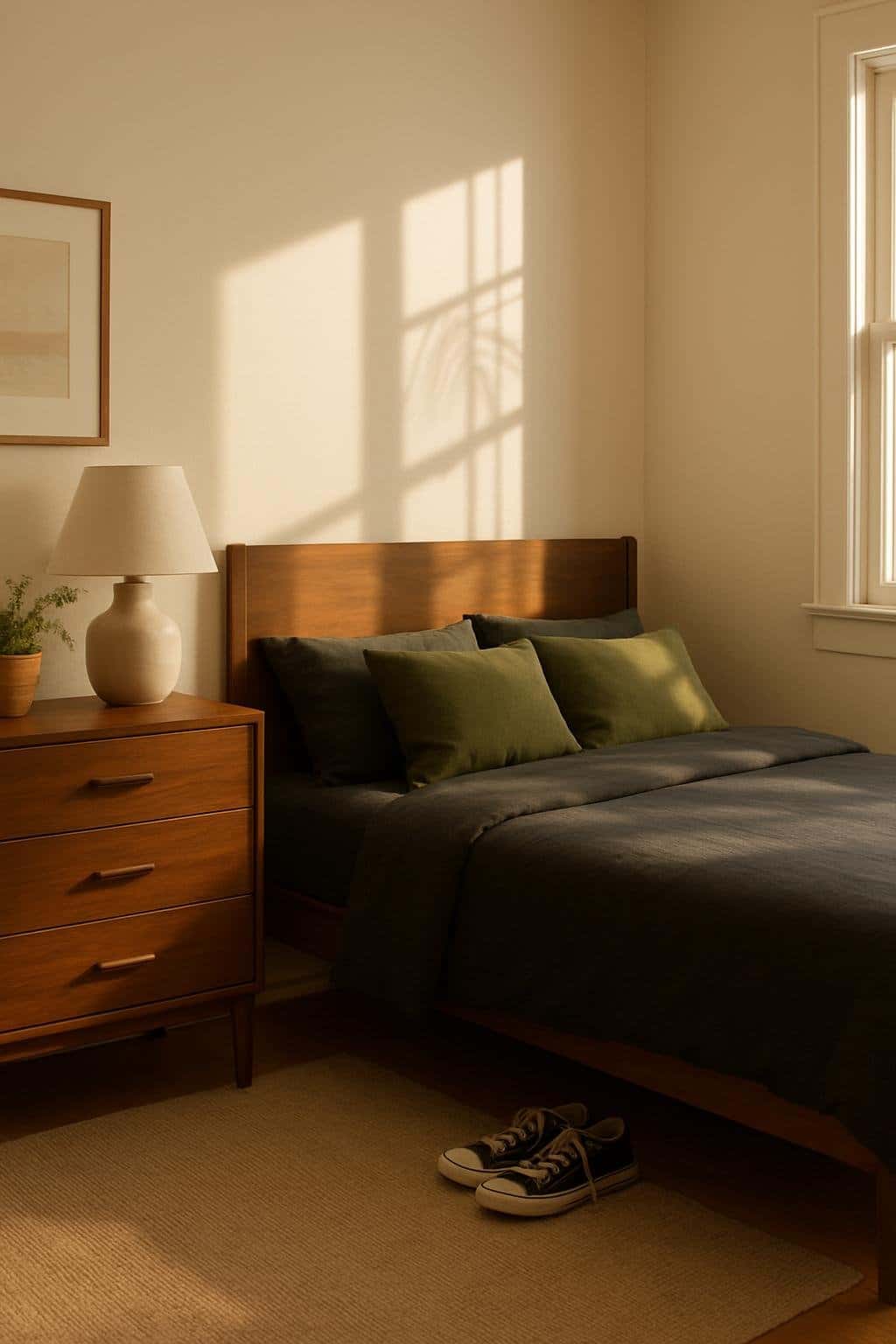
Deep charcoal textiles set a calm, grounded tone. Walnut wood brings warmth that balances darker shades.
When sunlight enters at golden hour, it softens the room’s edges and highlights textures in both fabric and furniture. Charcoal bedding works best when layered with different textures.
Charcoal Bedding Creates A Sophisticated Mood
A smooth cotton duvet, a quilted coverlet, and a knit throw keep the bed from looking flat. These layers add depth but keep the palette consistent.
The color itself carries weight. Charcoal absorbs light, creating a cocoon-like effect and making the bed the anchor of the room.
Pair charcoal with lighter accents to avoid heaviness. Ivory pillow shams, a pale beige sheet set, or a soft alabaster wall color help keep the space balanced.
Mixing tones gives you contrast without losing the restful mood. Here’s a quick guide:
- Base color: Charcoal duvet or comforter
- Accent: Light neutral sheets
- Texture: One or two throws in wool or knit
Walnut Furniture Warms The Palette
Walnut furniture adds warmth that keeps dark bedding from feeling too stark. Its natural grain adds variation, softening the sharpness of charcoal tones.
A walnut nightstand or dresser brings visual balance. The mid-brown finish pairs well with almost any bedding fabric.
Against charcoal, the wood looks richer and more defined. Place walnut pieces near natural light to show off their depth in both color and texture.
You can also use walnut in smaller ways—a tray on the nightstand, framed mirror, or lamp base ties the palette together.
These accents connect the bedding to the rest of the space. When choosing finishes, remember:
- Matte walnut = understated and modern
- Polished walnut = a bit more formal
- Distressed walnut = casual and relaxed
Golden Hour Shadows Stretch Across The Floor
Golden hour light changes the mood of your room. As the sun drops, warm tones highlight fabrics and wood, softening the darker shades of charcoal bedding.
The space feels calm but visually layered. Shadows stretch across the floor, drawing attention to textures in rugs, bedding, and furniture edges.
This natural contrast adds depth without extra décor. Keep windows clear of heavy curtains to maximize the effect.
Sheer panels filter light without blocking it. Position the bed or dresser where sunlight lands for a striking highlight in the evening.
For best results, keep in mind:
- West-facing windows = longest golden hour light
- North-facing windows = softer, cooler tones
- Minimal window coverings = stronger shadow play
Lavender Layers For A Dreamy Retreat
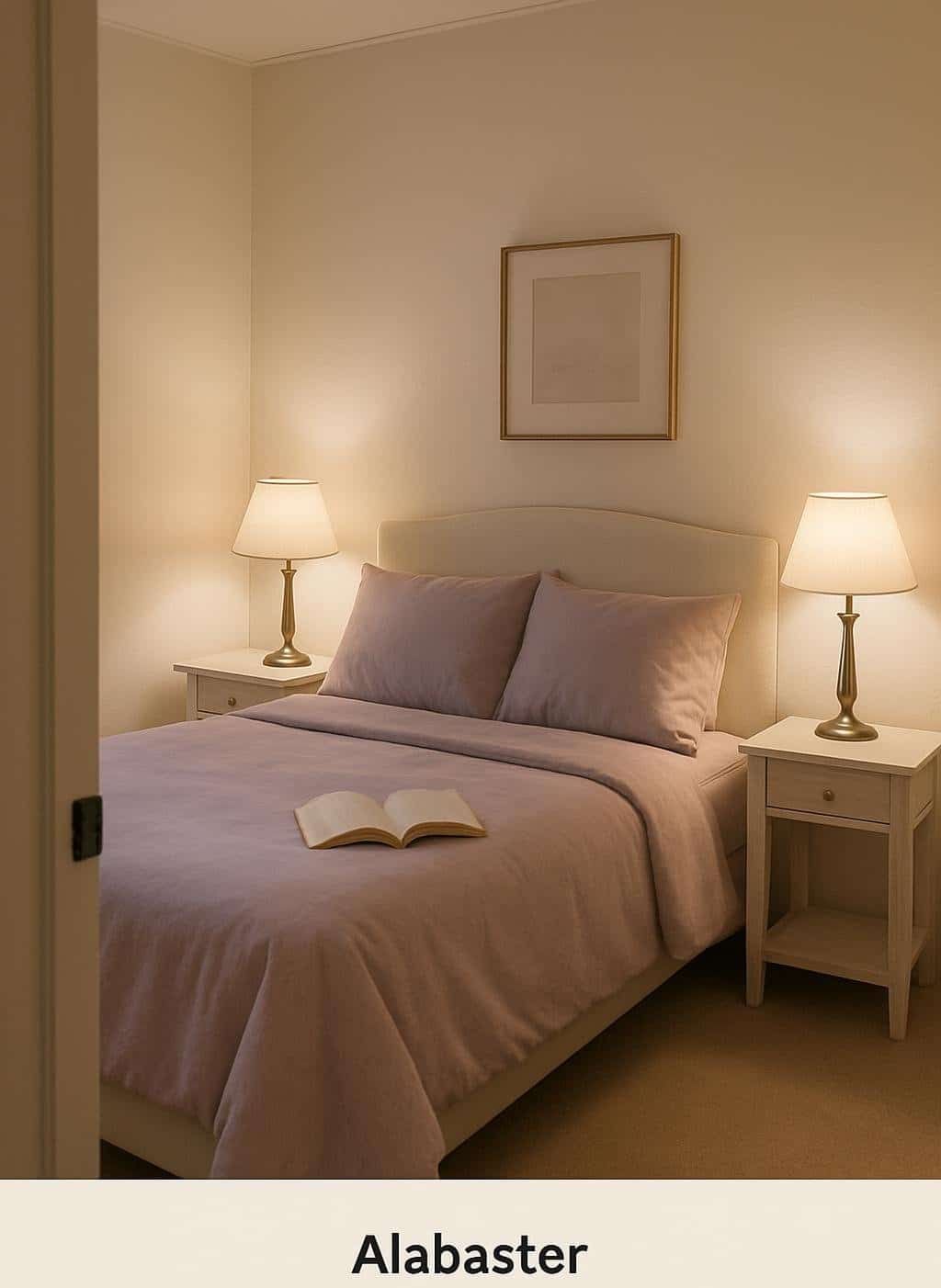
Soft lavender tones bring calm to your space and pair well with neutral finishes like alabaster walls. By combining gentle color, light furniture, and warm lighting, you get a balanced room that feels restful but not plain.
Lavender Bedding Adds A Romantic Softness
Lavender bedding introduces a subtle layer of color that’s soothing and inviting. Go for pale lilac sheets for a delicate look or deeper lavender duvets for more weight.
Both options work against alabaster walls, giving the room contrast without overwhelming it. Lavender textiles offer flexibility, too.
A quilted coverlet, linen duvet, or soft cotton sheets can each add texture while keeping the palette calm. Mixing materials—linen pillowcases with velvet throw cushions—creates depth without clutter.
Keep accent pieces simple for a cohesive look. A lavender throw at the foot of the bed or a pair of matching pillow shams ties the color into your design.
This approach avoids visual noise and helps the room feel restful.
Whitewashed Nightstands Keep The Palette Airy
Nightstands in a whitewashed finish help keep things light and open beside your bed. They complement alabaster walls and stop the lavender bedding from feeling too heavy.
The pale wood tones bring in a natural element without stealing focus from the main color scheme. Storage should be practical but not interrupt the design.
Pick pieces with clean lines and minimal hardware so furniture blends in. Drawers or shelves in a whitewashed finish let you keep essentials close by and surfaces uncluttered.
Pair these nightstands with neutral lamps or simple décor, like a ceramic vase or small greenery. The goal is to support the lavender accents, not compete with them.
Evening Lamps Cast A Warm, Glowing Tone
Lighting shapes the mood of your bedroom, and evening lamps are key to a soft retreat. Pick lamps with fabric or frosted glass shades that diffuse light gently.
This reduces harsh shadows and creates a warm glow that flatters both alabaster walls and lavender bedding. Bulb choice matters, too.
Warm white bulbs, usually around 2700K, give a gentle tone that feels calm and restful. Avoid cool white light, which can make lavender look stark and the space less cozy.
Placement is just as important. Put lamps on both nightstands for balance and symmetry.
Even lighting makes the room feel complete and supports a relaxed evening routine.
Forest Green Comfort In Cloudy Light
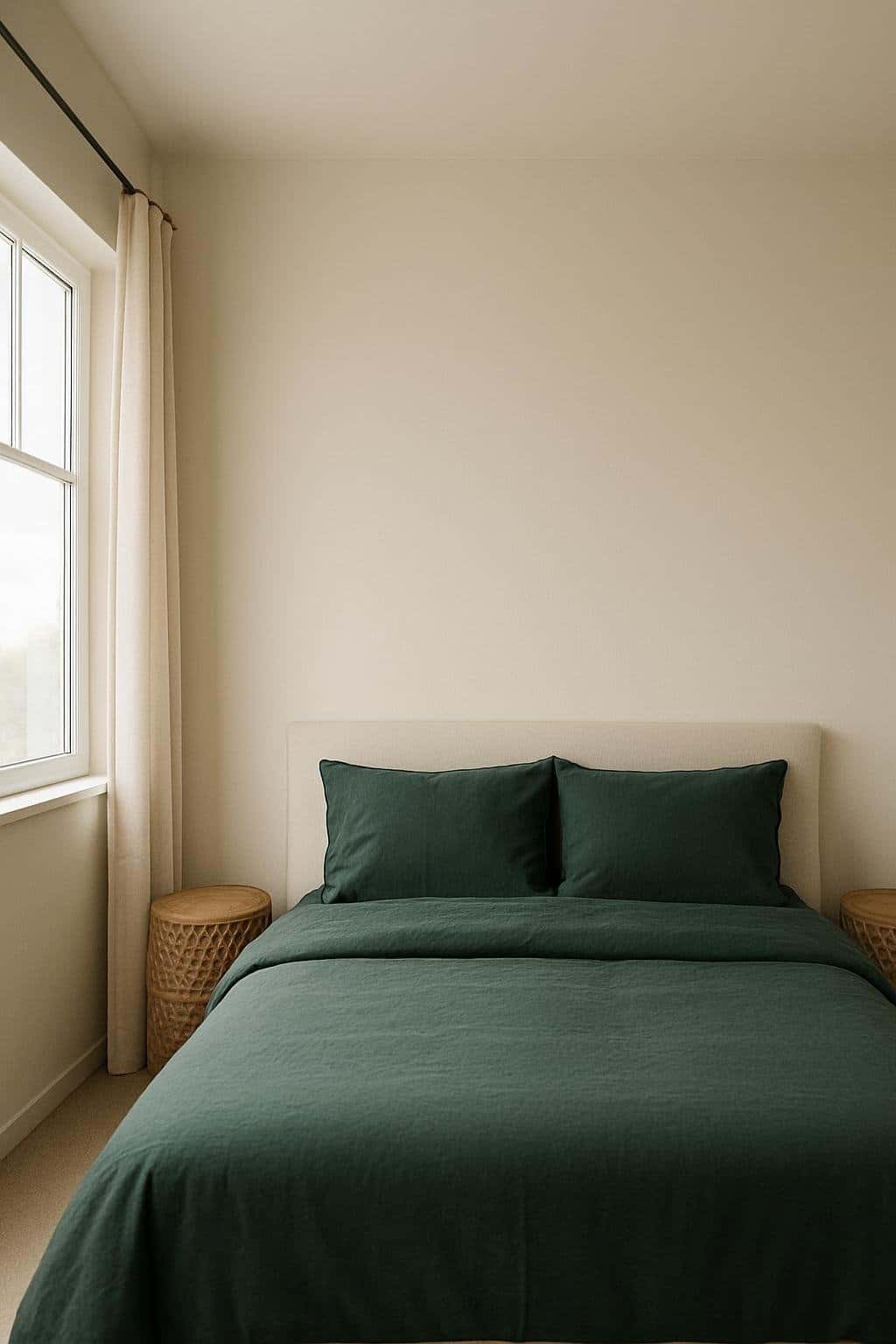
A restful bedroom can balance rich color with soft light and natural textures. Using forest green, woven accents, and muted daylight creates a calm space that feels steady and grounded.
Forest Green Bedding Adds Depth And Coziness
Forest green bedding gives your room a strong anchor. The deep tone adds weight to the bed, making it the visual center.
Pair it with crisp alabaster walls to keep the color from feeling too heavy. Try layering different fabrics in the same shade:
- Cotton sheets for everyday comfort
- Velvet throw pillows for softness
- Wool or knit blankets for warmth
This layering keeps the look cohesive while adding texture. Forest green also works with muted neutrals like beige or gray, which prevent things from feeling overwhelming.
If you want a softer effect, use lighter greens like sage for pillow shams or accent throws. This keeps the depth of forest green while adding a bit of variety.
Rattan Side Tables Bring Natural Texture
Rattan furniture adds a tactile element that balances the darker tones of green. A rattan side table brings warmth without drawing too much attention.
Its woven surface casts subtle shadows, a nice contrast with smooth bedding and painted walls. You can use rattan in small doses if you like a restrained look.
A single side table or a woven storage basket might be enough. For a stronger effect, pair two matching rattan nightstands with simple alabaster lamps.
Rattan also works well with other natural materials. Wood floors, linen curtains, or jute rugs fit in the same palette and reinforce the relaxed style.
Since rattan is lightweight, the room never feels crowded, even with darker bedding.
Cloudy Daylight Keeps The Palette Grounded
Soft, cloudy daylight really shapes how forest green shows up. Direct sunlight tends to make the shade look harsh.
Diffused light lets the depth of the color come through without any annoying glare. Try placing your bed near a window with sheer curtains to filter the light in a natural way.
Neutral wall colors like alabaster or light gray bounce cloudy daylight around nicely. This helps keep the room from feeling too dark when you use forest green bedding.
If your room doesn’t get much natural light, you can fake it with frosted bulbs or lampshades that soften the brightness. That trick works surprisingly well.
Terracotta Accents For Cozy Evenings

Terracotta goes great with warm neutrals like Alabaster. The combo makes a bedroom feel calm and inviting.
When you mix in natural textures and thoughtful lighting, you get depth and contrast. It’s especially nice in the evening, when you want a sense of comfort.
Terracotta Pillows Add Warmth To Neutral Walls
Alabaster walls set the stage for terracotta pillows to really pop. The earthy tone stands out against that soft white, giving your bed a clear focal point.
You can layer terracotta pillows with beige, cream, or muted gray cushions. This keeps the palette balanced but still interesting.
For a more pulled-together look, try pillow fabrics in linen, cotton, or velvet. These choices soften the contrast and tie the terracotta to the room’s neutral base.
A simple arrangement idea:
- Put two large terracotta pillows at the back.
- Add two smaller neutral pillows in front.
- Top it off with one patterned accent pillow in the center.
Dark Walnut Furniture Enhances Richness
Terracotta accents look deeper next to dark walnut furniture. The rich brown wood pairs perfectly with those earthy red tones.
Walnut nightstands or a dresser offer nice contrast with Alabaster walls. They also reinforce the warmth of terracotta, which just feels right—never too trendy or stark.
When you’re picking finishes, go for matte or satin instead of high gloss. That way, the furniture doesn’t feel stuffy and the room stays relaxed.
You might add walnut through smaller details like a wooden lamp base, picture frame, or a tray for your nightstand. These little touches stretch the richness without making things feel crowded.
Afternoon Sunlight Makes The Space Glow
Terracotta really shines in natural light. When afternoon sun pours in, those warm undertones show up and the space feels extra cozy.
Try to place your bed or a chair where it’ll catch some of that light. Terracotta pillows or throws will look more vibrant during the day and mellow out as evening comes.
If sunlight’s not in the cards, warm-toned LED bulbs can do the trick. Look for bulbs labeled 2700K–3000K—they give off a golden glow, kind of like late afternoon.
Using terracotta in spots that get sunlight or soft lamp light lets the color shift throughout the day. It keeps your bedroom feeling dynamic, but still restful.
Closing
When you think about bedrooms in Alabaster, you get this blend of comfort and practicality. Rentals and retreats here usually keep things simple, aiming for restful sleep and quiet surroundings.
You can pick from king or queen beds, private suites, or even cozy cabins. Each choice gives you a spot to recharge, with as few distractions as possible.
Here are a few things you might see:
| Feature | What It Means for You |
|---|---|
| King Bed | Extra room to stretch and relax |
| Queen Bed | Comfortable for couples or solo |
| Glamping Tents | Outdoor feel with modern comfort |
| Jacuzzi Suites | Added relaxation in your room |
If privacy matters most, maybe go for a house rental with several bedrooms. Want something a bit out of the ordinary? Glamping sites and spa resorts near Alabaster offer some pretty peaceful alternatives.
Your pick really comes down to how you like to rest. Whether you’re after a quiet retreat, a spa-focused getaway, or just a simple room, there’s a bedroom here that’ll probably fit what you need.

